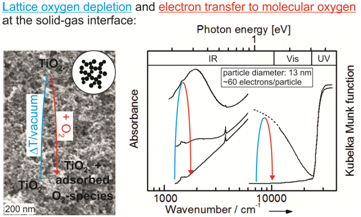STOICHIOMETRY CHANGES AND FUNCTIONAL PARTICLE SYSTEMS
WG4 members: Oliver Diwald, Thomas Berger
homepage: www.uni-salzburg.at/index.php?id=63605
Fundamental understanding of surfaces and interfaces associated with natural and engineered nanoparticles is a major objective of environmental and materials science. Our research addresses the impact of stoichiometry related defects on the functional properties of reducible metal oxide particles (TiO2, ZnO, In2O3 and SnO2). For this purpose various spectroscopic techniques (UV-Vis-NIR, photoluminescence, electron paramagnetic resonance, FT-IR) as well as photoelectrochemistry will be used in an integrated approach. This methodology will allow for an unprecedented comparison between trends in stability and stoichiometry of reducible metal oxide nanoparticles, on the one hand, and those related to conductivity, photoactivity and reactivity of derived materials, on the other.

Spectroscopic fingerprints of nonstoichiometric TiO2-x nanoparticle networks before and after electron transfer to molecular oxygen.
Infrastructure and expertise: chemical vapor synthesis, sol-gel synthesis, particle and colloidal characterization techniques, X-ray diffraction, electron microscopy, UV-Vis NIR -Diffuse reflectance, photoluminescence, Mössbauer spectroscopy, electron paramagnetic resonance, FT-IR, photo-electrochemistry, spectro-electrochemistry, high vacuum approaches for advanced surface functionalization approaches (e.g. ALD).


